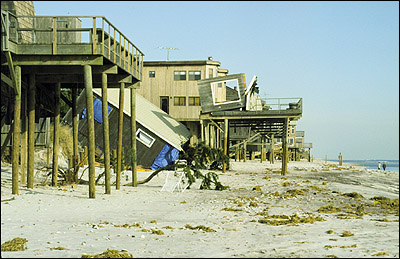![[Back] [Back]](../../../images/back.gif) |
Index | ![[Next] [Next]](../../../images/next-red.gif) |
Background
 |
| Severe Storm Damage. Photo: Dr. N. P. Psuty |
Nor'easters
The Perfect Storm (Halloween 1991)
 |
| Waves Crashing over the seawall, Halloween 1991 Nor'easter. Photo: Dr. N. P. Psuty |
An excellent technical case study of the Perfect Storm has been produced by the Synoptic Laboratory of MIT (http://paoc.mit.edu/synoptic).
December 1992 Nor'easter
The storm of record for New Jersey was the December 1992 Nor'easter. This storm caused damage along the shore that in places exceeded the '62 storm. The below pictures demonstrate the devastation that can be caused by improper management strategies at the shore.
 |
| Examples of damage from the Nor'easter of 1992 on Fire Island, NY. Photos: Dr. James Allen, USGS/NPS |
Hurricanes
Hurricane Floyd (1999)
Hurricane Floyd caused significant devastation on New Jersey in September, 1999. The state was declared a Federal disaster area with many millions of dollars in damaged. However, even with the Hurricane force winds (it was a class 2 hurricane when it made landfall it reached NJ) there was little damage done to the coast. Most of the damage occurred as flooding and took place inland as the storm stalled for many days. Only very minor effects were seen at the shore.
Hurricane Gloria (1985)
Gloria caused more damage along the shore, but even her impact was small. Water levels, and storm surge, associated with hurricanes is typical less than the severe Nor'easters, and because Hurricanes travel at a greater cross-ground speed they have less time to impact the coast. Gloria, infact, moved so rapidly that tides were only significantly elevated for one tidal cycle, and resulted in only minor erosion and damage from water along the coast.
![[Back] [Back]](../../../images/back.gif) |
Index | ![[Next] [Next]](../../../images/next-red.gif) |
